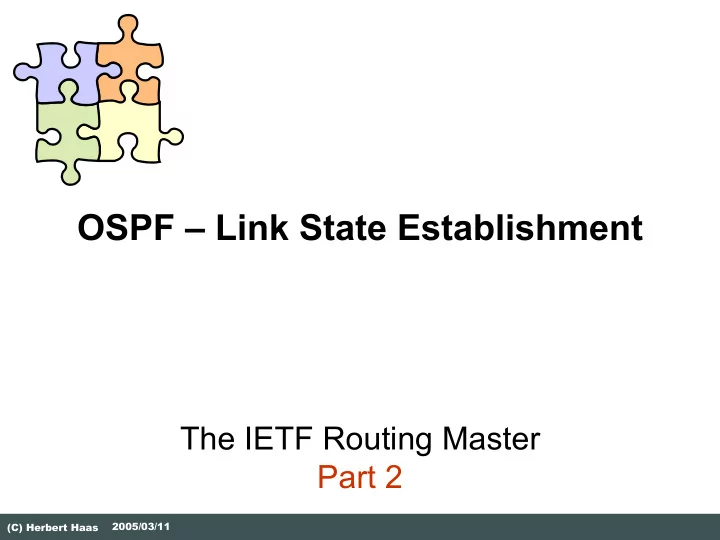

OSPF – Link State Establishment The IETF Routing Master Part 2 2005/03/11 (C) Herbert Haas
Basic Principle (1) Consider two routers, lucky integrated in their own networks... 2005/03/11 (C) Herbert Haas 2
Basic Principle (2) Suddenly, some brave administrator connects them via a serial cable... Both interfaces are still in the "Down state" What do we have here...? ? ? ? Let's make a link there! 2005/03/11 (C) Herbert Haas 3
Basic Principle (3) Init state: Friendly as routers are, they welcome each other using the "Hello protocol"… Hello Hello 2005/03/11 (C) Herbert Haas 4
Basic Principle (4) Two-way state: Each Hello packet contains a list of all neighbors (IDs) Even the two routers themselves are now listed (=> 2-way state condition) Both routers are going to establish the new link in their database... Hello Hello 2005/03/11 (C) Herbert Haas 5
Basic Principle (5) Exstart state: Determination of master (highest IP address) and slave Needed for loading state later Exchange state: Both router start to offer a short version of their own roadmap, using "Database Description Packets" (DDPs) DDPs contain partial LSAs, which summarize the links of every router in the neighbor’s topology table. Database Description Database Description Note: Networks are called "links". DDPs contain links and associated router-IDs of the originators of the corresponding LSAs. 2005/03/11 (C) Herbert Haas 6
Basic Principle (6) Loading State: One router (here the right one) recognizes some missing links and asks for detailed information using a "Link State Request" (LSR) packet... LS Request 2005/03/11 (C) Herbert Haas 7
Basic Principle (7) The left router replies immediately with the requested link information, using a "Link State Update" (LSU) packet ... LS Update 2005/03/11 (C) Herbert Haas 8
Basic Principle (8) The right router is very thankful, and returns a "Link State Acknowledgement"... LS Ack 2005/03/11 (C) Herbert Haas 9
Basic Principle (9) Then the left router recognizes some unknown links and asks for further details... LS Request 2005/03/11 (C) Herbert Haas 10
Basic Principle (10) The right router sends detailed information for the requested unknown links... LS Update 2005/03/11 (C) Herbert Haas 11
Basic Principle (11) The left router replies with a link state acknowledgement – a new adjacency has been established... Neighbors are "fully adjacent" and reached the "full state" LS Ack 2005/03/11 (C) Herbert Haas 12
Basic Principle (12) Both routers tell all other routers about all local adjacencies by flooding link state advertisements (LSAs) Both routers now see their own IDs listed in the periodically sent Hello packets LSA LSA LSA LSA LSA LSA These are so-called "Router LSAs". Other LSA types will be explained soon... 2005/03/11 (C) Herbert Haas 13
Database Inconsistency When connecting two networks, LSA flooding only distributes information of the local links of the involved neighbors (!) 2005/03/11 (C) Herbert Haas 14
Solutions Every router sends its LSAs every 30 minutes (!) Long inconsitency times Optionally flash updates configured Upon receiving an LSA a router not only forwards this LSA but also immediately sends its own LSAs Cisco default (can be turned off) 2005/03/11 (C) Herbert Haas 15
Finally: Convergence! When LSAs are flooded, OSPF is quiet (at least for 30 minutes) Only Hello's are sent out on every interface to check adjacencies Topology changes are quickly detected Default Hello interval: 10 seconds (LAN, 60 sec WAN) Hellos are terminated by neighbors 2005/03/11 (C) Herbert Haas 16
Recommend
More recommend